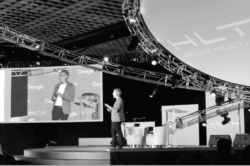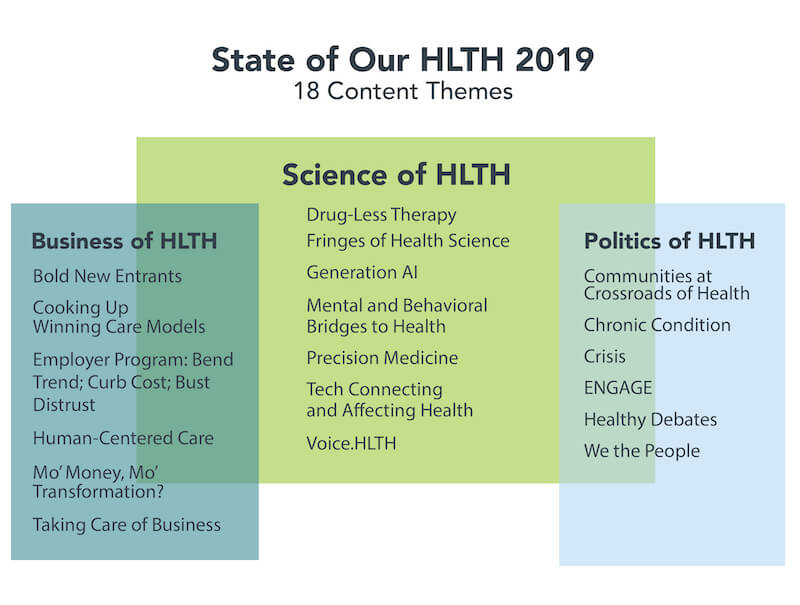March 4, 2020

The State of Our HLTH 2019: Hard Truths and Hope. A Post-Conference Report from HLTH 2019.
HLTH engaged 4sight Health to produce this exclusive post-conference report of the HLTH 2019 conference. HLTH gave 4sight Health and its five-member writing team carte blanche to attend all theme and general sessions during the four-day event. 4sight Health’s charge was to report through its lens the essential takeaways for healthcare leaders who are shaping the future of health and healthcare delivery in the U.S. and around the world.
David Johnson, 4sight Health CEO, led the team and wrote the report’s executive summary, presented below. Nathan Bays, David Burda, Keith Hollihan, David Johnson and Lindsay Morrison from 4sight Health wrote the reports for each of the 18 themes at HLTH 2019. You can download the entire report on the HLTH website here.
Highlights
- 6,400 participants – payers, providers, employers, investors, startups, pharma, policy makers and innovation centers – came from more than 40 countries.
- By design, HLTH attendees replicate healthcare’s massive, chaotic and often contradictory ecosystem.
- 18 content themes covered the Politics of HLTH, the Business of HLTH, and the Science of HLTH.
- Consumer health’s demographic barbell. Boomers and millennials are advancing consumerism in health from both ends of the demographic spectrum.
- Primary care’s dynamism. The health ecosystem is in the process of deconstructing primary care services and reassembling them in new and interesting ways to solve specific consumer health needs.
- Whole-person health. The impact of negative social determinants of health was a consistent theme, as was the importance of “reconnecting the head back to the body, of totally integrating mental health into total health.” (Bernard Tyson)
- Tech and human services. Innovators are applying tech to improve human understanding and performance, to ease access, educate consumers, personalize service provision and complete repetitive tasks.
- Policy alignment on health reform. A parade of Obama and Trump health leaders echoed the need for pro-market and pro-consumer policy reforms.
(download the entire report here)
Executive Summary
From Oct. 27 through Oct. 30, 2019, more than 6,400 payers, providers, employers, investors, startups, pharma, policy makers and innovation centers from more than 40 countries gathered at the MGM Grand in Las Vegas to attend the second HLTH conference.

That was a 68 percent increase in the number of attendees from HLTH’s inaugural 2018 event.
During HLTH 2019, participants confronted healthcare’s hard truths and explored solutions for addressing the industry’s dysfunction. Unlike some sprawling healthcare conferences, where most participants do not attend the actual conference, there is a commonality of experience at HLTH that expands perspectives and challenges conventional wisdom.
Everyone at HLTH is in one arena, walking the same hallways, absorbing the industry’s ubiquity, diversity and universality within the same highly curated environment. By design, HLTH attendees replicate healthcare’s massive, chaotic and often contradictory ecosystem. It’s clear that the ecosystem is deeply out of balance.
As illuminated in HLTH’s opening “stats video,” the current state of U.S. health is depressing:
- Healthcare costs were $3.7 trillion in 2018 and will rise 5.5 percent annually through 2027
- Healthcare consumes 18 percent of the $20.5 trillion U.S. economy
- Almost 80 percent of Americans worry that a major health event could bankrupt them
- Medical error is now the third-leading cause of death
- Chronic disease afflicts 60 percent of adults and consumes 90% of healthcare expenditure
- More people die from opioid overdoses than in car accidents
- 27 percent of young Americans are too overweight to serve in the military
- Suicide is now the second-leading cause of death for people aged 10-24
- 20 percent of adults experience mental illness and over half fail to receive treatment
- American moms today are 50 percent more likely to die in childbirth than their mothers
Despite these dismal statistics, there are real reasons to believe that system transformation is both possible and achievable. Smart tech is making health access, education, navigation and monitoring easier, cheaper and more effective.
AI and ML enable clinicians to diagnose and treat disease earlier and with more precision. Fifty-two million Americans use wearable devices, and 80 percent own smart home devices. Advocates say telemedicine can effectively handle 75 percent of doctor, urgent care and ER visits.
Health services are decentralizing to more convenient and consumer-friendly venues, including retail locations and, most importantly, the home. This repositioning creates enormous opportunities for health companies to develop value-creating products and services that advance individual and community health.
Moreover, these advances in technology and convenience come with a greater understanding of what creates health and how to address its social determinants. Mental and physical health are increasingly treated in an integrated manner. Done well, preventive care reduces the need for acute interventions and promotes well-being, productivity and happiness.
Dramatically lower gene editing and genetic sequencing costs and advances in genetic engineering are sparking breakthrough treatments for debilitating diseases including sickle cell anemia and certain cancers. Precision medicine with targeted therapies is increasing survival rates. Advances in device manufacturing are creating human-like tissues and organs.
In his opening remarks, HLTH Founder, Chairman and CEO Jonathan Weiner captured this transformative moment in the health industry’s history with insight and clarity.
Participants in the health ecosystem are driving toward transformation, literally transitioning from yesterday’s legacy systems and outdated models to tomorrow’s scientific innovations, disruptive technologies and heeding to the consumer’s appetite for personalized, affordable and effective care.
At its core, HLTH believes that transformation of the health ecosystem is not an option but a collective obligation. This passion for revolutionary change is the shared belief that gives purpose and energy to the HLTH experience. Channeling Ghandi, HLTH asks its community to be the change in health they wish to see in all communities where Americans live, work and play.
The venue and the experience
HLTH’s embrace of technology enables it to personalize attendee experience. HLTH arranged more than 6,000 one-to-one meetings and 75 roundtable discussions. The HLTH app enabled individual attendees to design their content program and arrange their own meetings. As a consequence, attendees experienced a curated HLTH event tailored to their preferences.

HLTH’s initiatives went far beyond professional matchmaking and conference navigation. For example, “WOMEN at HLTH” was a major initiative that increased representation of women on-stage, conducted targeted programs to increase workplace diversity, celebrated success stories and asked organizations to take a “parity pledge” to interview and consider at least one woman for all open executive positions. There also was a HLTH/HACK “hackathon” and an Advancement League charity event for young health leaders. The Advancement League and the HLTH Foundation joined forces in a friendly competition that resulted in more than 6,000 meals, hundreds of volunteer expertise hours and thousands of dollars for mental health, housing and food security programs in Las Vegas.
A walk from the hotel through the MGM casino to the conference center constituted a journey through many of the challenges facing American healthcare that HLTH attendees and exhibitors are trying to solve. Moving through the casino, HLTH attendees passed through a parade of overweight smokers, gamblers and tourists battling chronic disease and their own behaviors. There was even a small store where baseball legend Pete Rose talked to his fans and signed memorabilia for a fee. After the casino, attendees passed through a long dark tunnel with blue tinsel and signature life-sized caricatures of HLTH’s main-stage speakers before emerging into a panoply of exhibits, demos and presentations. HLTH world was bursting with spectacle, including celebrity performers, hard-pumping hallway music, strobe lights, onstage DJs and bands before general sessions.
More than 400 exhibitors large and small pitched their value propositions to the masses of attendees walking the exhibit hall floor. Amid the exhibit booths was a book nook where authors did book signings. There were breakfasts, lunches and receptions for everyone.
Weiner describes HLTH as “an event for a new generation of health innovation” that assumes a proactive role in promoting industry transformation. By design, HLTH brings leaders together at scale and across interests, so that the right people have the right conversations at the right time. In doing so, HLTH strives to build programs and create environments that promote significant and lasting transformation.
This is the principal reason that people come to HLTH and stay through the event. They want to engage with fellow innovators who are creating health’s future. Consumer tech and services companies attended and sponsored HLTH. These included Google, Lyft, IBM, Intel, MasterCard, Microsoft, Uber and Verizon. With apologies to Hamilton, like traditional sponsors, these new entrants want to be “in the room where it (health transformation) happens.”
Program themes
HLTH assembled programming for 18 content themes. These themes covered topics related to the business and science of health as well as health policy. Each theme had three to six sessions that addressed specific topics. Sessions consisted of presentations, panels, fireside chats and debate formats.

We summarized and covered the 18 content themes and wrote the individual summaries contained in the full report. Each summary identifies key findings, discusses challenges and solutions, lists session participants, a memorable quote and an indicative data point.
Collectively, the breadth and depth of the HLTH content themes impressed us. Individual sessions were 40 minutes and ran on time. Moderators and presenters were well-prepared, and panel discussions moved quickly. Technology streamlined audience question and answer exchanges.
There were 24 general session presentations during which heavy hitters from business, government and academia covered health policy, emerging business models, innovation, discovery and consumerism. Andy Slavitt’s interview of Mark Cuban generated significant interest.
Cuban asserted that that healthcare leaders are not truly disrupting their businesses and exhibited a pugilistic willingness to punish companies he believes are bad actors. Deep pockets and a passion for value-driven change can be lethal to incumbent business practices.
5 Key Takeaways
Synthesizing HLTH’s key takeaways could be an Olympic event. Dozens of attendees took to social media to share their HLTH experiences and highlight their insights. From my perspective, the following five themes emerged as the most important from HLTH’s deliberations:
1. Consumer health’s demographic barbell
Boomers and millennials are advancing consumerism in health from both ends of the demographic spectrum. Boomers are not going quietly into that good night. They are signing up in record numbers for Medicare Advantage programs tailored to their preferences. MA obliterates fee-for-service medicine by shifting care management to third parties. Boomers also refuse to let the Healthcare Industrial Complex® dictate their end-of-life care. Like they always have, Boomers are demanding attention and redefining service provision. Watch out.
The oldest Millennials turn 40 in 2020, and they’re beginning to pay attention to health in their own unique, digitally-native way. Millennials believe hospitals are only for really sick people, and most don’t have primary care physicians. When and only when they need it, on-demand care is just a click away and delivered in a convenient, personalized and transparent manner. The
generation that taught us how to ride with strangers is redefining the design and provision of health services. Health will never be the same.
2. Primary care’s dynamism
The health ecosystem is in the process of deconstructing primary care services and reassembling them in new and interesting ways to solve specific consumer health needs. The one-size-fits-all primary care practice with short visits and referrals for tests/specialty care is becoming obsolete. It is being replaced by these new forms of primary care service delivery:
- Enhanced primary care practices that build long-term member relationships
- Accountable care organizations that accept care management risks
- Specialized primary care that serves targeted groups (e.g. young women)
- Intense primary care services for dual eligible populations
- Virtual primary care targeted to specific needs (e.g. reproductive care)
- Retail primary care clinics (e.g. in Walmart stores)
Large self-insured employers are betting big on primary care to improve employee health and reduce care costs. Walmart is partnering with Grand Rounds to direct its associates to high-performing primary care practices. Comcast has partnered with Crossover Health to deliver primary care services in on-site, nearby and virtual clinics to all 180,000 of its employees nationwide. Both programs are achieving spectacular results.

Among HLTH’s more entertaining sessions was a debate regarding business models, results and scale among the founders of three transformational primary care companies. Farzad Mostashari, M.D., (Adelade) and Clive Fields, M.D., (VillageMD) emphasized that providing ACO services to existing primary care practices scales quickly, improves care outcomes and lowers total care costs by 15 percent. Rushika Fernandopulle, M.D., (Iora Health) acknowledged that employed PCPs with smaller patient panels don’t scale as quickly but asserted they achieve even better outcomes while reducing total care costs by 40 percent.
3. Whole-person health
Health titan and Kaiser Permanente Chairman and CEO Bernard J. Tyson died unexpectedly shortly after HLTH. In his keynote address at HLTH, Tyson emphasized the necessity of “reconnecting the head back to the body, of totally integrating mental health into total health.” Tyson worked tirelessly to take care of people when they were well so they wouldn’t get sick.
Overcoming a transaction-focused sickcare model may be Tyson’s enduring legacy. The health ecosystem is beginning to follow his lead and seeing results. Addressing social determinants of health was a consistent theme throughout HLTH. Several innovative upstarts and incumbents are embracing SDOH as central to their business models.
Isolation is different than loneliness. While often related, addiction is different than depression. Appropriate mental health care requires investment in targeted and personalized therapies that not only treat patients in moments of crisis but help them manage their conditions long term.
Historically underfunded, mental and behavioral health care is now receiving more attention, more funding and carries less stigma for those receiving treatment, but it is far from being universally available and offered. Patrick Kennedy, author of the 1996 Mental Health Parity Act, acknowledged the shortfall and warned that America’s embrace of vaping legal and illegal substances will lead to a catastrophic increase in substance abuse and addiction, further stressing today’s mental health system.
4. Tech and human services
David Feinberg, M.D., “introduced” Google Health during a keynote address. Feinberg described their mission as “organizing the world’s health information and making it universally accessible and useful.” He acknowledged that Google makes this “magical journey” alone. Feinberg ended his talk by asking the HLTH community to join Google in seeking to advance health together by harnessing data’s potential.

What’s interesting is how companies like Google are applying tech to improve human understanding and performance. For example, many providers are using AI to predict bottlenecks and nudging frontline staff with suggestions for resolving issues before they manifest.
Likewise, virtual care companies use their tech to ease access, educate consumers, personalize service provision and complete repetitive tasks. Their platforms offer human-based services when appropriate for higher-order medical diagnosis, advice and/or treatment.
The goal is to achieve the right balance between tech and human services, so that consumers receive the right care at the right time in the right place at the right price.
5. Policy alignment on health reform
In the closing general session on HLTH’s opening day, CMS Administrator Seema Verma gave a major policy address regarding the government’s role in healthcare provision. Verma’s walk-on music, “Won’t Back Down” by Tom Petty, amplified her steadfast determination to push for pro-market pricing and regulatory policies that level competition, foster innovation and deliver value to American consumers.
Verma is not alone in pushing for market-based reforms that increase transparency, reduce waste and enhance care outcomes. HLTH has partnered with United States of Care, led by Verma’s predecessor at CMS Andy Slavitt, to advance bipartisan health reform. A parade of Obama and Trump health leaders, including Verma, Slavitt, Zeke Emanuel, Adam Boehler, Greg Simon and Eric Hargan echoed the need for pro-market and pro-consumer policy reforms.
My favorite moment on policy reform occurred when Oak HC/FT Managing Partner Annie Lamont pushed Deputy HHS Secretary Hargan on the data interoperability and the data blocking that’s frustrating innovative app developers.
Lamont noted, “We’ve had carrots.” She then asked in rapid-fire sequence, “Where are the sticks? What are you doing to Epic? How are you going to make them behave?” Hargan mentioned “serious fines” and then they both agreed that we need to liberate health data “for the good of the country!”
Conclusion: HLTH’s brave new world
America does not need to spend more than 18 percent of its GDP to provide great health to everyone in the country. We need to spend less on acute and specialty care and spend more on primary care, health promotion, chronic disease management and mental health services. The challenge isn’t what to do, it’s how to do it.
HLTH’s mission is to spotlight the health ecosystem’s fundamental flaws and assemble the people and organizations with the wherewithal to eliminate them. As Jonathan Weiner observed, transformation will require exponential change, and there will be clear winners and losers. That’s what’s required to achieve better, more equitable and affordable health for all Americans.
The HLTH community is not shying away from transformation. It is embracing the challenge and making transformation happen. It is for this reason, I expect that HLTH 2020 at Caesars Forum Conference Center in Las Vegas will be even bigger and bolder than HLTH 2019.
Register for the HLTH 2020 Oct. 11-14, Las Vegas
Come to HLTH 2020 to learn, network, take action and enjoy great thinking on how our industry is changing. HLTH features more than 300 groundbreaking speakers representing a wide range of organizations, health services, technologies and passions. All these experts have one common goal – to disrupt, question and redesign the current health system. You choose whatever panels and presentations to attend, moving between the 21 different themes. Register here.






